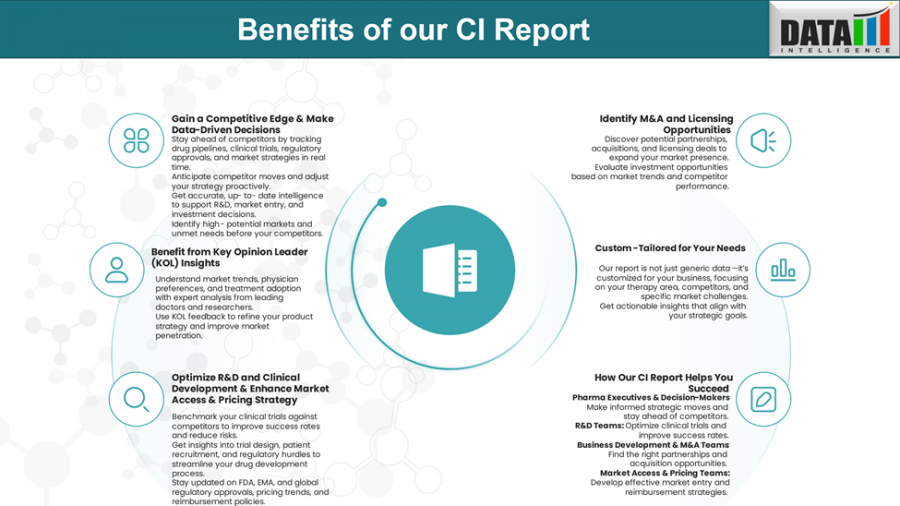
Generalized Myasthenia Gravis 2025: From Broad Immunosuppression to Targeted Biologics and Cellular Therapies
gMG care is shifting from steroids to targeted therapies-complement inhibitors, Fc modulators, cell therapies offering improved safety and durability in 2025.
AUSTIN, TX, UNITED STATES, July 2, 2025 /EINPresswire.com/ -- Generalized Myasthenia Gravis (gMG) is a chronic, autoantibody-driven neuromuscular disorder marked by fluctuating muscle weakness and fatigue. As autoimmune antibodies target acetylcholine receptors (AChR) or muscle-specific kinase (MuSK), neuromuscular junctions lose efficiency, leading to symptoms that can severely impair daily life.
Historically managed with broad immunosuppressants and symptomatic relief, gMG is witnessing an exciting transformation. New precision therapies-from complement inhibitors and FcRn modulators to CAR-T-like cell therapies-are now entering late-stage trials, offering targeted immune modulation, improved safety, and durable impact.
Download CI Sample Report: https://www.datamintelligence.com/strategic-insights/ci/generalized-myasthenia-gravis-gmg
🧬 Disease Overview & Burden
Generalized MG affects roughly 1–2 people per 10,000 globally, often diagnosed between ages 20–40 and again in older adults. Patients experience muscle weakness in ocular, bulbar, limb, and respiratory muscles-leading to impaired mobility, breathing difficulty, and severe fatigability.
Diagnosis combines clinical assessment, antibody testing (against AChR, MuSK, LRP4), and electrophysiological studies like repetitive nerve stimulation. The disease profoundly impacts physical functioning, independence, and mental health. Standard therapies achieve symptomatic control in most patients, but many continue to rely heavily on steroids and treatments with long-term side effects.
🌍 Current Treatment Landscape
- Cholinesterase Inhibitors (e.g., pyridostigmine) improve neuromuscular transmission and alleviate fatigability.
- Corticosteroids and Conventional Immunosuppressants (e.g., azathioprine, mycophenolate, cyclosporine) reduce antibody production but carry risks like osteoporosis, diabetes, infection, and cancer.
- Plasma Exchange / IVIG are used for rapid symptom control during crises or severe cases.
These treatments are effective but imperfect-chronic steroid toxicity and systemic immunosuppression remain significant issues. Moreover, therapeutic responses vary, and relapse is common.
🔬 Emerging Precision Therapies & Pipeline Developments
Recent breakthroughs are revolutionizing gMG treatment by targeting key immune pathways:
Complement Inhibitors
- Eculizumab (anti-C5) was first approved, showing significant symptom improvement in refractory gMG, but requires biweekly IV infusions and increases meningococcal risk.
- Ravulizumab (longer-acting C5 inhibitor) offers 8-week dosing intervals.
- Zilucoplan (subcutaneous C5 inhibitor) enables self-administration, with emerging Phase III readouts.
FcRn Modulators
Novel agents modulate neonatal Fc receptor to reduce pathogenic IgG recycling:
- Efgartigimod alfa showed clinically meaningful improvements in weakness and fatigue in Phase III.
- Rozanolixizumab, nipocalimab, and batoclimab are progressing in later-stage trials, with SC delivery options appealing for home use.
B-Cell and Plasma Cell Therapies
- Rituximab depletes CD20+ B cells but is off-label in MG.
- Inebilizumab targets CD19+ cells more broadly, now in advanced trials.
- Plasma cell-directed agents are emerging to address refractory disease by eliminating antibody-producing cells.
Cellular & Gene-Driven Approaches
- CAR-T cell platforms targeting B cells (e.g., BCMA or CD19 directed) are in early development.
- Gene therapies aiming to induce long-term immune tolerance are in preclinical stages.
Stem Cell Transplant
- Autologous stem cell transplant shows promising results for rituximab-refractory patients; Phase II/III studies are continuing.
Book Free CI Consultation Call: https://www.datamintelligence.com/strategic-insights/ci/generalized-myasthenia-gravis-gmg
🔍 Competitive Landscape & Strategic Positioning
Complement Inhibitor Class
Eculizumab established proof-of-concept; newer alternatives offer improved convenience (rilucizumab, indolent subQ zilucoplan) and reduced infection risk.
FcRn Modulator Class
Efgartigimod and its peers aim for rapid induction of IgG depletion with convenient routes-offering steroid-sparing potential within weeks rather than months.
Cellular Approaches
CAR-T platforms may offer single-shot, durable benefits. Although earlier in development, they could redefine refractory disease management if safety is confirmed.
Clinical Niches & Patient Segmentation
- Refractory and difficult-to-treat patients remain a primary focus.
- Individuals seeking steroid reduction or improved maintenance regimens will benefit from effective SC or infrequent IV therapies.
- Antibody-positive patients (AChR or MuSK) may require specific agents based on dominant pathogenic mechanisms.
🎯 Target Opportunity Profile (TOP)
For new gMG therapies to excel, they should meet the following criteria:
- Efficacy: Significant reduction in MG-ADL, MGFA classification, and ability to taper or discontinue steroids.
- Safety: Low risk of infections, malignancy, or PML; minimal infusion reactions.
- Mechanism: Aligned with patient antibody profiles (C5 vs FcRn vs B/plasma cell targeting).
- Administration: Home-based SC delivery preferred; frequency no more than once monthly.
- Onset & Durability: Rapid symptom relief (<1 month) and sustained effect over 6–12 months.
- Economic & Regulatory Fit: Orphan designations, health economics analysis, and real-world cost-effectiveness for broad adoption.
Ask for customized CI Sample Report as per Your Business Requirement: https://www.datamintelligence.com/strategic-insights/ci/generalized-myasthenia-gravis-gmg
🗓 2025–2027 Outlook & Milestones
Key anticipated developments:
- Phase III results for zilucoplan, rozanolixizumab, and inebilizumab are expected, potentially enabling FDA/EMA approvals by 2026.
- CAR-T cell therapy initial safety data may emerge by 2027 in select centers.
- Real-world adoption trends will shift toward SC and oral steroid-sparing agents.
- Evolving reimbursement frameworks will favor agents demonstrating value through efficacy and quality of life gains.
✅ Conclusion
The gMG treatment landscape in 2025 is marked by precision, durability, and patient-oriented innovation. From complement blockade to FcRn modulation, the entry of targeted therapies offers a pathway to reduce reliance on broad immunosuppression. Cell-based and gene-altering approaches hint at long-term remission or functional cure. For patients, caregivers, and clinicians, the promise is clear: meaningful disease control with fewer side effects and improved daily life.
Read Related CI Reports:
1. Eosinophilic Esophagitis | Competitive Intelligence
2. Prurigo Nodularis | Competitive Intelligence
Sai Kumar
DataM Intelligence 4market Research LLP
+1 877-441-4866
sai.k@datamintelligence.com
Visit us on social media:
LinkedIn
X
Distribution channels: Healthcare & Pharmaceuticals Industry
Legal Disclaimer:
EIN Presswire provides this news content "as is" without warranty of any kind. We do not accept any responsibility or liability for the accuracy, content, images, videos, licenses, completeness, legality, or reliability of the information contained in this article. If you have any complaints or copyright issues related to this article, kindly contact the author above.
Submit your press release
